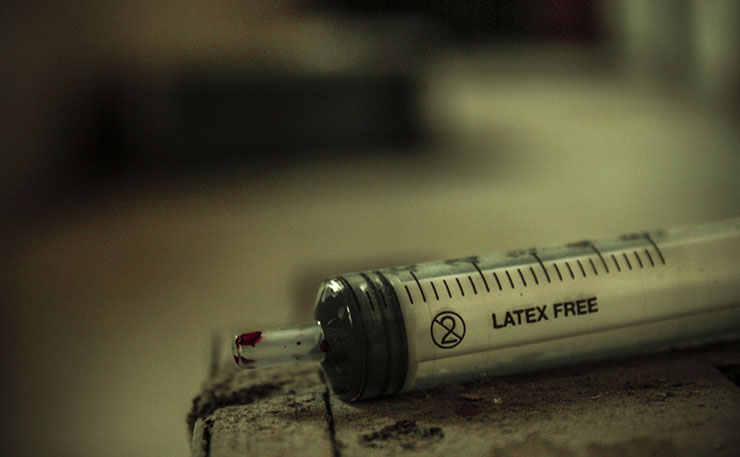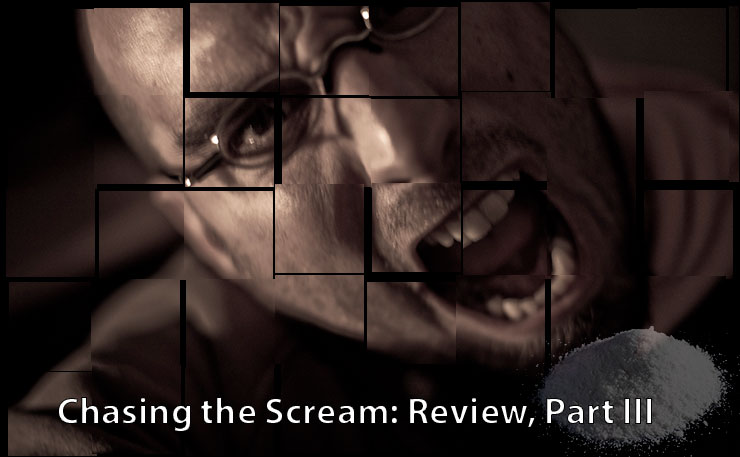This is the third in a four part New Matilda series by Michael Brull, reviewing Chasing the Scream, a book by journalist Johann Hari that examines the ‘War on Drugs’. In this article, Brull looks at whether or not decriminalisation of drugs actually works.
Towards the end of the book, Hari reviews various places which have decriminalised drugs in various forms. He finds the results encouraging. I will review his treatment of three examples: a clinic in Britain, and the new approaches to drugs in Switzerland and Portugal.
Decriminalisation – the cocaine and heroin clinic in Britain
First, there was the case of doctors in the United Kingdom who wanted to prescribe heroin to addicts. They did so until the American government pressured the British government to end this practice, and the Brits gradually buckled.
Dr John Marks was one doctor who tried this approach in the town of Widnes, prescribing heroin and cocaine in his clinic to his patients from 1982 to 1995. He was writing prescriptions for heroin and cocaine for around 450 patients.
During the period of his drug prescribing clinic, Dr Mark had zero drug-related deaths among patients.
Local police reportedly found 142 heroin and cocaine addicts in his local area.
In the 18 months before he started writing prescriptions, they had an average of 6.88 criminal convictions. In the following 18 months, they averaged 0.44 criminal convictions. This was a 93 per cent reduction in theft and burglary.
According to Hari, when this program was ended, 20 of the patients were dead within 6 months, and 41 had died within 2 years.

Research comparing Widnes to a comparable area in Liverpool found that the comparative use of heroin massively declined – from 207.54 users per hundred thousand in Booth, to just 15.83 in Widnes.
Hari argues this is because drug dealing operates like a pyramid scheme. Addicts buy drugs, then they cut their product and try to push it onto others to recoup some of their expenses.
The search for customers and profit was undercut by the clinic. Addicts would get their drugs, without having a reason to push them onto others. It is also presumably a challenge to sell drugs illegally when a doctor nearby gives them out.
It should be noted, Hari claims that “a slew of studies” have shown that “natural recovery” is standard: “almost all” addicts, who survive their addiction, will naturally stop. They usually do so “after around 10 years of use”. Presumably, the goal of such clinics is to provide drugs safely, and in time they will grow out of their addiction naturally (in part four of this review, I will return to Hari’s treatment of this issue).
For those who think drugs are bad and no-one should ever be allowed to use them, the British trial may not mean much. Reducing crime and keeping drug users safe might seem like the crucial considerations to others. However, as far as positive evidence goes, it was only applied in a particular area to a small number of people.
Decriminalisation – Switzerland
Switzerland, on the other hand, is a country of some 8 million people. In the early ‘90s, it began to try a different approach to dealing with drugs.
Now, addicts can go to a clinic to get heroin. If an addict wants a higher dose, she can ask for it. And she’ll get it. Hari writes that “at first, most addicts demand more and more… But within a few months, most addicts stop asking for more and choose, of their own free will, to stabilise their doses.”
Hari says that given the option of a safe legal prescription, and the ability to control their dose, “the vast majority will stabilise and then slowly reduce their drug consumption over time.”
Hari argues that prescribing heroin is “for many people a path” to stopping drug use.
There is no limit to how long they can get the drugs for. Hari says, “the average patient will come here for three years, and at the end of that time, only 15 per cent are still using every day.”
According to Hari, the effects of the clinics were positive. He writes:
“The parks and railway stations that were filled with addicts emptied. Today, children play there once again. The streets became safer. The people on heroin prescriptions carry out 55 per cent fewer vehicle thefts and 80 per cent fewer muggings and burglaries. This fall in crime was ‘almost immediate,’ the most detailed academic study found.
The HIV epidemic among drug users stopped. In 1985, some 68 per cent of new HIV infections in Switzerland were caused by injection drug use, but by 2009, it was down to approximately 5 per cent.
The number of addicts dying every year fell dramatically, the proportion with permanent jobs tripled, and every single one had a home.
A third of all addicts who had been on welfare came off it altogether.
And just as in Liverpool, the pyramid selling by addicts crumbled to sand: people on the heroin prescription program for a sustained period were 94.7 per cent less likely to sell drugs than before their treatment.…
The program costs thirty-five Swiss francs per patient per day, but it spares the taxpayer from having to spend forty-four francs a day arresting, trying, and convicting the drug user.
So when people ask ‘Why should I pay for this?’ the pragmatic Swiss answer is: This doesn’t cost you money. It saves you money.”
Some may think Hari’s account of the program ignores downsides, or otherwise overstates the benefits. Yet in 1997, there was a national referendum over the drug laws. 70 per cent of Swiss people backed the new approach.
The conservatives tried again in 2008. This time, “68 per cent backed the policy”. Try to think of a political reform in Australia in a controversial area (other than same-sex marriage) which would get 70 per cent backing.
Above all else, this public response renders dubious any fearmongering about the catastrophic consequences of decriminalising drugs, in Australia or elsewhere.
Decriminalisation – Portugal
Hari also explores the case of Portugal, which in the 1980s, had “one of the worst heroin addiction problems in the world… By the early 1990s, fully one in one hundred people in the country were addicted to smack.”
In 1999, the government created an independent commission of nine people, with judges, doctors, and an academic, to figure out how to address the drug problem. It recommended that “drug users should be treated as full members of society instead of cast out as criminals or other pariahs.”
Rather than aiming at “zero drug use”, they would almost entirely decriminalise the personal possession of drugs. The money that had been spent on arresting, trying and imprisoning drug users would now be spent on education and rehabilitating addicts.
From 2001, Portugal stopped imprisoning drug users. Police don’t search people for drugs. However, if someone is blatantly using drugs in public, or is caught with drugs in the course of some other activity by police, then from the second occasion, they can be given a small fine of about 80 Euros. However, this will not be imposed by the police.

On the first occasion a police officer finds someone using drugs, they take them to the Dissuasion Commission. There is no threat of any criminal penalties, and it is designed to be informal and non-threatening. The user will chat to a psychologist.
If the psychologist doesn’t think you’re an addict, they’ll give you tips on the safe use of drugs, and then leave you alone.
If you are an addict, it’ll be pretty similar. The Dissuasion Commission “can’t oblige anyone to do anything”, observes one of their resident sociologists. They just try to guide addicts towards treatment.
Users do not have to fear any repercussions of admitting that they do have a drug problem. The new law apparently provides that users should “above all, not be labeled or marginalised”. Addicts should be approached by the state exclusively to “encourage him or her to seek treatment”. Having enough drugs for 10 days personal use is no longer a crime. Selling drugs is still illegal though.
The state tries to rehabilitate addicts and remove the stigma of use and addiction. It “gives a hefty yearlong tax break to anybody who employs a recovering addict. Almost always, when the year is up, the employer keeps the former addict on in his garage or bakery or shop, because she has turned out to be a good worker”.
Were there catastrophic results of this bold new policy?
Hari writes: “Two highly respected and impartial bodies have studied the outcomes: the European Monitoring Centre for Drugs and Drug Addiction (EMCDDA), and the British Journal of Criminology. They have no horse in this race. Their role is solely to figure out what actually happened.”
They found that “there has been a slight increase in overall drug use, from 3.4 to 3.7 per cent of the population.” However, “Portugal started with a low rate of use, except for heroin, and it stayed low compared to other countries. The EMCDDA found Portugal is ninth lowest out of 28 countries when it comes to cannabis use, fifth lowest when it comes to amphetamines, and fifth lowest when it comes to ecstasy. Over a decade after full decriminalisation, Portugal has, they found, ‘a level of drug use that is, on the whole, below the European average and much lower than its only European neighbour, Spain.’”
Perhaps it was to be expected that in a country that by law aims not to label or marginalise the use of drugs, the use of drugs would increase. For those concerned with the harms caused by drugs, other findings might be taken as more significant. Hari writes:
“The Portugese Ministry of Health says that the number of problematic drug users has literally been halved, from a hundred thousand to fifty thousand. The British Journal of Criminology confirms it is down, but found a more modest decline, from 7.6 people per thousand, to 6.8, while confirming that injecting drug use has indeed been almost halved, from 3.5 injectors per thousand people to 2.
When they compared the situation to the nearby countries of Spain and Italy, which are still waging the drug war, they found that ‘Portugal is the only of these nations to have exhibited declines’ in problematic drug use.
… the British Journal of Criminology found that overdose has been “reduced significantly,” and the proportion of people contracting HIV who get it from drug use has fallen from 52 per cent to 20 per cent.
[EMCDDA says that] in 1999, 2.5 per cent of sixteen-to-eighteen-year-olds used heroin. By 2005, after six years of this model of decriminalisation, it was down to 1.8 per cent.”
Joao Figueria is the Chief of the Lisbon Drug Squad, and identifies as “very conservative”. He expected the drug reforms to be a disaster, predicting an “explosion of consumption”.
Now, he says, “The things we were afraid of… didn’t happen.” Figueria says that “What happened here was a good result, and the statistics we have here prove it. There is no ideology in this… Now everyone, conservatives or socialists, accepts the situation.”
Hari reports that since the drug policy revolution, Portugal has had two left-wing governments, and two right-wing governments. All of them have kept the decriminalisation policy in place. None of them misses the criminalisation approach, which seems to have vanished from the political agenda.
Like Switzerland, the fact of public acceptance is arguably the strongest proof that the reforms have worked well.
For those interested, Glenn Greenwald wrote an excellent and very persuasive paper on decriminalisation in Portugal for the Cato Institute in 2009, which I encourage readers to check out.
Greenwald concludes that, “The data shows that, judged by virtually every metric, the Portuguese decriminalization frame-work has been a resounding success.”
Donate To New Matilda
New Matilda is a small, independent media outlet. We survive through reader contributions, and never losing a lawsuit. If you got something from this article, giving something back helps us to continue speaking truth to power. Every little bit counts.





